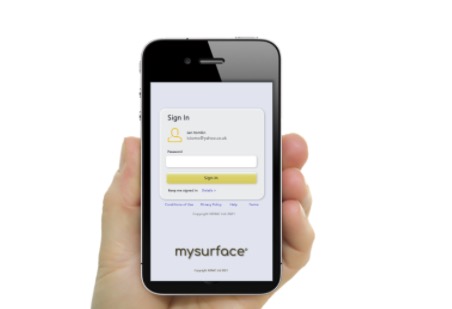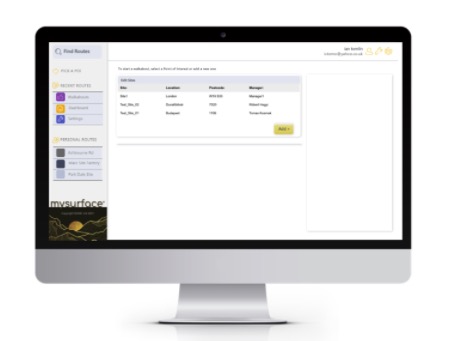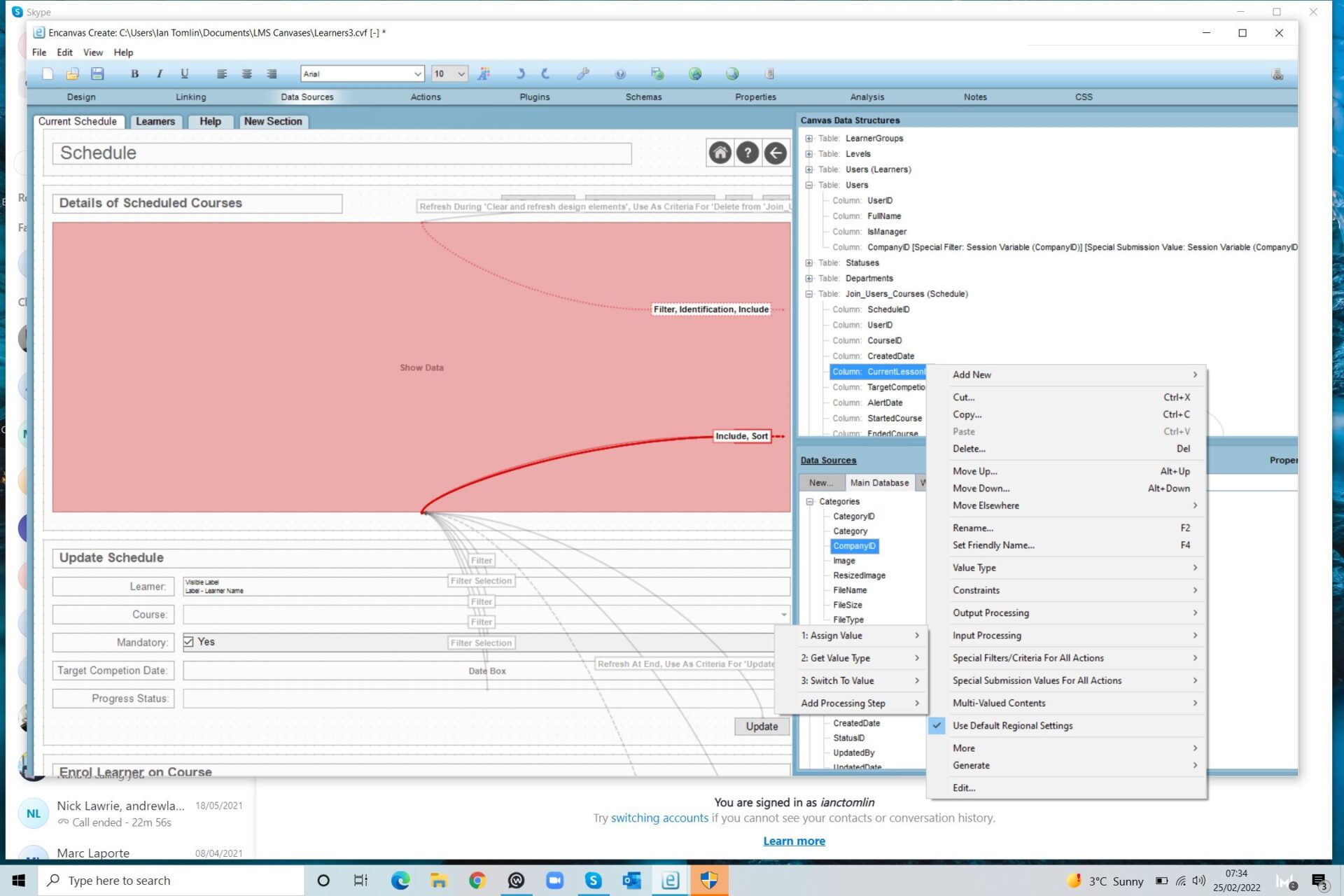EXPERIENCE ENCANVAS IN 60-MINUTES!
We're always happy to walk you through Encanvas no matter where you are in the world.

Every business manager today has a mind brimming with ways to improve their business best served by developing self-authored custom apps. How can no-code software development produce professional, safe and scalable solutions that integrate with your existing back-office

It’s quite remarkable how many fantastic business ideas spring out of moments when leaders and entrepreneurs have time to let their minds wander. Be it in the shower, at the gym, or during the morning walk, inspiration can strike and you find yourself planning out your next great business project.
At one time, you had to be a programmer to turn ideas into software apps. not today. No-Code software development gives every business leader to opportunity to turn their bright ideas into code.
Whether it’s conjuring up a new enterprise, improving a process that saves money, building a new product, or finding ways to deliver giving value to customers, good ideas these days rely on software technology to make them real.
While off-the -shelf apps are perfect for automating those typical processes that every business needs to deal with—accounting, financial management, Human Resources and payroll, staffing, web conferencing etc.—the things that make your business different will need new apps to be authored. That’s where no-code software development comes in.
Think back to Y2K. If you wanted an app, for most organizations, the only way to achieve it was to create an internal coding team, or outsource it to a third-party developer. Both of these resourcing approaches has its issues.
Building an in-house expert team is expensive, time-consuming, and takes time—not to mention the fact that there’s a global shortfall in IT skills. Even when you have the right people, and have invested in the right coding platforms, there’s no guarantee that what gets produced will be what you need. The casebook of failed application development (‘appdev’) projects is littered with examples of companies that have tried and failed to create apps themselves on-time and on-budget with internal teams. No-code software development means every business can afford to create custom apps for their business. Teams are smaller, and IT risks are lowered.
Hiring an external dev team always risks intellectual property. Managing internal teams can be a challenge for managers, and results are always driven by the economics of the project. As soon as the money runs out, the development stops—and this can lead to poor quality results, where all the finishing touches are missing. For me, perhaps the biggest issue however is what happens post delivery. Applications always need adaptation and enhancement over time. With external teams, there’s no guarantee the people that worked on the project will be around when you need them to enhance and improve the apps they develop.
Examples of mobile and web desktop applications designed and deployed using no-code software development


Thankfully, there is a new THIRD WAY to get your app produced and published that brings with it reduced problems post-project, because you will always be able to update the app whenever requirements or markets change. And that new way is an Enterprise App Platform.
No-code software development is made possible by adopting a no-code application Platform as a Service. This is a cloud platform that equips businesses to design, deploy and run their own apps.
Usually these days, the design aspect of creating apps is democratised by using building-block styled No-Code interfaces , so that business people can get hands-on in specifying and building apps themselves. The design tools are designed for use in workshops in near-real-time, so expect to be able to deliver an app in days and weeks, not months and years.
Deeper, more technical aspects of managing an enterprise app platform are served up with dashboards and tooling designed for IT architects and people that went to college to study computing as a discipline.
Enterprise app platforms are a game-changer for transforming the creative opportunities of business leaders and managers. They equip businesses to go digital and adapt apps to respond to change as often as necessary, without any great cost (or IT) burden.
No surprise then that the market for No-Code and Low-Code Enterprise App Platforms is going crazy at the moment. Gartner is suggesting the global Low-Code/No-Code Development Platform Market will tip $187 billion to 2030.
There are two lurking IT project killers that destroy the hopes and ambitions of sponsors more than anything a development team will or won’t do. They are the two evils of data quality and data integration.
Like lurking evil titans, these two problem areas sometimes seem designed to derail the ambitions of humans. I can’t think of an application of any description that doesn’t depend on any other system for ANY of its data.
This is when the world goes dark. Suddenly, appdev teams find they don’t know how to connect to systems, or at least they don’t know how to connect without risking performance or security impacts on the existing systems.
Every app in existence these days requires the creation of user identities and logins, of company records, connections to order processing or accounting systems. Before you know it, your little no-code app concept must connect to one or many existing or new IT systems. Furthermore, as you harvest data, you will need to de-dupe it, organize it, transform and add data. For that you will need a toolkit.
To connect to one or many systems and harvest elements of data you need for your new app, you will require the following:
No-code data connectors will equip your app to harvest existing data repositories to capture the data you need. Sometimes, this is frowned upon because of the data processing loadings it places on servers. Other time, vendors are reluctant to share their data– so you will also need the next feature.
Software robot workflows (sometimes called Robotic Process Automation, or ‘RPA’ in the industry) will equip your app to harvest data from existing data sources. In circumstances where you cannot connect directly to a data source, another way of harvesting data is to extract a report from a system, or key-fill a spreadsheet template. With this feature, you will be able to upload data from spreadsheets, XML or CSV reports.
Extract, transform and load (ETL) tooling will enable you to clean-up, normalize and adapt your data to fit the new data processing requirement.
A data-mashup capability will equip you with the necessary tooling to blend data from different sources together in new ways.
Poor quality data can make a good app look bad. It can also make an app unusable, or of little value.This is why it’s so important to make sure your Enterprise App Platform comes with the right blend of capabilities, not just to design, deploy and manage apps across your business, but also to help in the resolution of data integration and quality challenges.

1. Extract, Transform and Load (ETL) tools and bots – This feature allows you to create ways to pump data from different systems (that may be located at different physical locations, or locked behind firewalls) to serve up data from existing systems, to then extract, transform and load it into your new app. Often, this sort of tooling will use if/then logic rules to validate, adapt and enrich data as it is uploaded.
2. Ready-to-Use Data Connectors – This is tooling that connects your app (and the server it sits on) to third-party systems that have data of differing types stored in differing ways.
3. Data Mashup support – This is about blending ‘bits of data’ from one data source, with ‘other bits of data’ from another to populate tables. One key technical aspect of this feature is that it needs to be multi-threading. This describes an ability to keep the data connections in use ‘open’ as needed.
4. Plug-In Support – It’s handy to be able to use third-party app components and data sources as part of new application developments. When using third-party components, app designers will want to be able to act on the data in the native design environment and not have to ‘code’ changes in database systems prior to import. This is where plug-in tools like HYPER-DRIVE from ENCANVAS come in—to de-skill and simplify the task of harnessing IT existing app components.

Ian Tomlin is a management consultant and strategist specializing in helping organizational leadership teams to grow by telling their story, designing and orchestrating their business models, and making conversation with customers and communities. He serves on the management team of Encanvas and works as a virtual CMO and board adviser for tech companies in Europe, America and Canada. He can be contacted via his LinkedIn profile or follow him on Twitter.
Now read:

Encanvas announces the launch of HyperDrive, giving app designers the means to embed practically any data source or digital component into enterprise processes.
OXFORD-UK, 29th April 2021 – ENCANVAS today announced the release of HyperDrive™, an enhancement to its enterprise app platform designed to give businesses an adaptive digital ecosystem to bridge between existing back-office tools and front-end websites to improve customer self-service transparency and experience.
This move towards use of digital technologies to bring differentiating value to customers means companies have become app innovation factories. Demand is fuelling a growing Rapid Applications Development tech industry and Low-Code app development solutions estimated to reach 1$46.4 billion by 2026.
HyperDrive™ is a new feature we are now including in ENCANVAS/4 as an optional upgrade. It’s a Universal Data Plug that means third-party code, script, apps or data sources can be embedded into ENCANVAS’s building block app ecosystem. What makes HyperDrive™ special lies in the way it allows app designers to incorporate new digital tech painlessly into their designs. Furthermore, any data received by HyperDrive™ can be pre-processed within ENCANVAS’s design environment bringing transparency and enormous control over consumed data.
<h3> ENCANVAS/4 with HyperDrive™ is on general release from 1st May 2021.</h3>
To request a trial, go to: https://www.encanvas.com/get-the-app/
Source:
1 – Report by KBV Research on the Global Low-Code Development Platform Market.
PRESS AND MEDIA CONTACT DETAILS:
Encanvas
Dove Cottage Offices, Abingdon Road, Marsham, Oxfordshire OX13 6NU, United KingdomTel: 02 3983 7001
info@encanvas.com
Media and Press Contacts:Newton Day Ltd
3rd Floor, 86-90 Paul Street, London, EC4a 2NE
Francesca Manleyfrancesca.manley@newtonday.uk
More Press Releases:

OXFORD-UK, August 10, 2020 – Encanvas today unveiled the latest version of its Enterprise-Grade Codeless Enterprise Applications Platform. Encanvas/4 makes it possible for the ideas people of an enterprise to create machine-to-machine and human-to-machine apps in workshops using Agile Codeless methods.
The global pandemic has raised demands on businesses to move to online sales and marketing. Business leaders are pressured to closely integrate their websites to back-office systems and orchestrate business models, one app at a time, to maximize customer experience while minimizing operating costs through hyper-automation.
This drive towards use of digital technologies to bring differentiating value to customers, means companies have become app innovation factories. This demand is fuelled a growing Rapid Applications Development tech industry and Low-Code app development solutions estimated to reach 1$46.4 billion by 2026.
Solutions for Rapid Applications Development in the market today target two separate audiences; so-called Citizen Developers that want to create apps themselves but lack coding skills, and IT Professionals engaged in applications development but seeking faster ways to deliver outcomes.
Encanvas/4 has been expressly designed to equip fast growing businesses and large enterprises with a secure private cloud app ecosystem to design, deploy and run as many apps as they need and change them as often as they like. Additionally, it provides the means to integrate existing data repositories and websites with core business systems to create a data driven business able to experience their customer landscape from the first contact to the latest transaction.
Encanvas claims its No-Code approach uniquely breaks down the divide between IT and the business by equipping Business Analysts with the means to support the end-to-end app ideation process, while further empowering IT teams to maintain data security, app deployment, performance, scaling and governance roles. Using Encanvas, businesses can displace self-authored shadow systems and spreadsheets, migrate human-in-the-loop processes to full automation, and simplify their app architectures and data models to cut legacy burdens while increasing data asset value.
With many firms considering or already engaged in digital transformations, Encanvas supplies the app ecosystem and integration-ware to support Hyper-Automation. It promises the fastest time to value while bringing together e-forms, robotic automation (RPA), artificial intelligence (AI), data science, and workflow in one platform.
Encanvas produces improved customer experiences and digital transformations one enterprise application at a time, delivered up to 10 times faster than Low-Code.
Originally launched in 2003, new features in the version 4.0 platform include:
• Live-Wireframing – Technology to design, create and publish ready-to-deploy prototypes without coding or scripting in workshops.
• AppFabric – Technology to manage the formation of private cloud app ecosystems, separating the ideation role duties of Business Analysts from the deep technical roles fulfilled by IT Professionals.
• Hyper-Drive – A Universal Data Plug that means third party code, script, apps or data sources can be fully embedded into Encanvas’s codeless ‘building block’ app ecosystem.
• Web iFrame Integration – Giving app designers an elegant way to integrate Encanvas forms and apps into their existing websites and app portals.
Encanvas/4 is generally available in October 2020.
Encanvas is an enterprise software company and the developer of the Encanvas Codeless Applications Platform. The Encanvas/4 codeless app ecosystem supports applications design, deployment and operation without coding or scripting. It produces enterprise-grade apps and helps change management teams to evolve business IT at the speed of light to maximize customer experience and minimize costs. Build the apps you need and change them as often as you like. Many of the world’s largest organizations have used Encanvas applications to automate, transform and grow. For more information, visit www.encanvas.com.
Source:
1 – Report by KBV Research on the Global Low-Code Development Platform Market.
PRESS AND MEDIA CONTACT DETAILS:
Encanvas
Dove Cottage Offices, Abingdon Road, Marsham, Oxfordshire OX13 6NU, United KingdomTel: 02 3983 7001
info@encanvas.com
Media and Press Contacts:Newton Day Ltd
3rd Floor, 86-90 Paul Street, London, EC4a 2NE
Francesca Manleyfrancesca.manley@newtonday.uk

Agile Codeless is a software development life-Cycle *(SDLC) approach that embraces codeless authoring methods and tools to produce enterprise apps. Developed by NDMC Consulting over a decade of enterprise software projects, it removes the barriers that exist between IT and the Business when authoring enterprise applications software.
A level of trial and error can be expected for any creative activity but the excessive risks of software authoring are born out in studies both in terms of slow time to market and burgeoning costs. The article ‘Why Your IT Project May Be Riskier Than You Think’ by HBR (November 2011) followed a survey of 1,471 IT projects with an average spend of $167m and found:
Though the pitfalls of software applications development are by now well documented the IT industry has been singularly unable to overcome them. But as globalization increases apace, business models change ever more rapidly and organizations seek to leverage ‘Big Data’, the need to reliably produce better applications right-first-time has never been more critical.
For a hundred years management thinking has valued mechanization over creativity…
..but after decades of automation, the core business processes of organizations are pretty slick – that is until markets change and business models need to realign. Then concepts of operational excellence evangelized by management consultants sound hollow.
As the very structure of markets change, smaller, more nimble companies benefitting from closer ties to their customers, and a clearer understanding of their value, are able to steal a march on vendors 100 times their size.
Even global brands aren’t safe – new aggressors can emerge from a different industry altogether to take a big bite out of a market they see as fair game in an open, global market-place (such as retailers venturing into the car insurance market for example).
“Institutionally, the ability to be agile enough is the gut issue in leading an organization today.” James McNearney – CEO, Boeing
Organizations that could once survive without reviewing business models more than once a decade are now forced to re-assess annually. The new mantra of business excellence is agility – to create an enterprise that can adapt to always win in its most addressable markets.
Key to the drive for agility is the need to empower middle managers; people with the energy, skills and curiosity to question why processes work as they do and find new ways to distil customer value. Leaders are coming to realize that leadership at all levels of the enterprise is vital. This critical tier of ‘corporals’ demand systems and tools to understand and adapt their assets and resources to fit internal processes to the ever changing business landscape.
This is driving demand for a new tier of applications that harvest data from existing sources to create new applications that response to new situations (‘situational applications’) as they arise and align IT systems to better fit constantly evolving processes.
Disparate silos of data across the enterprise – a known problem that has faced organizations for decades, but how do you fix it?
Services-Oriented Architecture is a term that describes the design and use of information services to support business needs; a coherent enterprise-wide method of organizing how computer systems present information to other systems so the data they manage can be accessed more easily without compromising systems performance or security. For business people, the major benefit of organizing information through SOA is the prospect that data held in disparate silos across the enterprise can be re-used to create new applications that produce smarter processes.
To consume Web Services requires applications able to bring data together while fashioning new data structures, web portals and forms-based applications to view, edit and update data.
Demand for these new applications increasingly comes from communities of workers that, while small in number, are essential to process innovation and creativity – things that create competitive advantage in the 21st century business world.
The conceived wisdom of building large lumbering enterprise applications for the majority at the expense of the few, no longer fits the reality of what these critical communities of information workers either need or expect. The high quality of software people now use in their homes and on their mobile phones has raised the bar of what business users expect. The digital native generation dismisses applications that require a manual or that ask them to live with inhospitable reporting tools.
To meet the demands of this new ‘consumerized’ user community, the only viable solution is to produce applications at a faster pace and at lower risk; getting new applications to market faster, at lower cost. This demand has led to the innovations found in the Agile Codeless methodology.
“Middle managers spend more than a quarter of their time searching for information necessary to their jobs, and when they do find it, it is often wrong.”
Source: AIMS survey on information management, 2007
Services-Oriented Architecture is a term that describes the design and use of information services to support business needs; a coherent enterprise-wide method of organizing how computer systems present information to other systems so the data they manage can be accessed more easily without compromising systems performance or security.
For business people, the major benefit of organizing information through SOA is the prospect that data held in disparate silos across the enterprise can be re-used to create new applications that produce smarter processes.
To consume Web Services requires applications able to bring data together while fashioning new data structures, web portals and forms-based applications to view, edit and update data.
Demand for these new applications increasingly comes from communities of workers that, while small in number, are essential to process innovation and creativity – things that create competitive advantage in the 21st century business world.
The conceived wisdom of building large lumbering enterprise applications for the majority at the expense of the few, no longer fits the reality of what these critical communities of information workers either need or expect. The high quality of software people now use in their homes and on their mobile phones has raised the bar of what business users expect.
The digital native generation dismisses applications that require a manual or that ask them to live with inhospitable reporting tools. To meet the demands of this new consumerized user community, the only viable solution is to produce applications at a faster pace and at lower risk; getting new applications to market faster, at lower cost.
Agile Codeless is a rapid method of designing and deploying situational applications for workgroups and teams. It’s codeless because applications are authored using a platform that supplies pre-formed building blocks of technology, negating the need to see or use programming code. The absence of code and script in design workshops is important because it removes the barriers between IT experts and business professionals responsible for scoping applications; probably because they are stakeholders and users of the app to be authored.
The ability to develop applications in near real-time (largely during workshops with users and stakeholders) not only makes applications ‘better-fit’ to the community of users and beneficiaries they’re intended for, but reduces the time, cost and risk of applications developments – all but removing testing, tuning and re-working costs.
Agile Codeless methods and tools dramatically reduce the skills needed for authoring applications which means that one individual can reasonably discharge the entire lifecycle. The fact that applications are authored ‘faster’ does not remove the need for quality gates or pre-qualification of the use-case, user needs and benefactor outcome expectations. Developments are by necessity heavily pre-scoped using formalized analysis methods that include:
Encanvas is an enterprise software company that specializes in helping businesses to create above and beyond customer experiences.
From Low Code to Codeless
Better than code-lite and low-code, we created the first no code (codeless) enterprise application platform to release creative minds from the torture of having to code or script applications.
Use Encanvas in your software development lifecycle to remove the barrier between IT and the business. Coding and scripting is the biggest reason why software development has been traditionally unpredictable, costly and unable to produce best-fit software results. Encanvas uniquely automates coding and scripting. Our live wireframing approach means that business analysts can create the apps you need in workshops, working across the desk with users and stakeholders.
When it comes to creating apps to create a data culture and orchestrate your business model, there’s no simpler way to instal and operate your enterprise software platform than AppFabric. Every application you create on AppFabric adds yet more data to your single-version-of-the-truth data insights. That’s because, we’ve designed AppFabric to create awesome enterprise apps that use a common data management substrate, so you can architect and implement an enterprise master data management plan.
Encanvas supplies a private-cloud Customer Data Platform that equips businesses with the means to harvest their customer and commercial data from all sources, cleanse and organize it, and provide tooling to leverage its fullest value in a secure, regulated way. We provide a retrofittable solution that bridges across existing data repositories and cleanses and organizes data to present a useful data source. Then it goes on to make data available 24×7 in a regulated way to authorized internal stakeholders and third parties to ensure adherence to data protection and FCA regulatory standards.
Encanvas Secure and Live (‘Secure&Live’) is a High-Productivity application Platform-as-a-Service. It’s an enterprise applications software platform that equips businesses with the tools they need to design, deploy applications at low cost. It achieves this by removing coding and scripting tasks and the overheads of programming applications. Unlike its rivals, Encanvas Secure&Live is completely codeless (not just Low-Code), so it removes the barriers between IT and the business. Today, you just need to know that it’s the fastest (and safest) way to design, deploy and operate enterprise applications.
Learn more by visiting www.encanvas.com.
Ian Tomlin is a management consultant and strategist specializing in helping organizational leadership teams to grow by telling their story, designing and orchestrating their business models, and making conversation with customers and communities. He serves on the management team of Encanvas and works as a virtual CMO and board adviser for tech companies in Europe, America and Canada. He can be contacted via his LinkedIn profile or follow him on Twitter.

You probably already know what a high productivity application Platform as a Service (HPaPaaS) is. You just know it under a different name.
Gartner coined the term High-Productivity application Platform as a Service (HPaPaaS) to describe rapid application development platforms that provide business developers with the tools to build enterprise applications rapidly – offered as a service – with one rapid deployment and other composite capabilities. Other than for the delivery mechanism, deployment methods and operational behaviours – Low-Code and HPaPaaS have overlapping capabilities and can be interchangeably used from a neutral point of view.
HPaPaaS platforms are provisioned on a subscription model with support for multi-tenancy and resource sharing.
The applications built using HPaPaaS should be able to seamlessly deploy on multiple devices without the need of writing code for different devices or operating systems.
The platform should have the capability to manage data models, documents and business processes. As these three form the base for most enterprise applications, it is imperative to natively support them.
The platform should enable business developers to easily build enterprise applications. It should support for a model-driven, drag-n-drop environment which simplifies the app development process.
As most enterprise applications will need to integrate with internal and external systems, HPaPaaS should support all integration mechanisms including API, Microservices, EDA, etc.
HPaPaaS essentially replaces traditional methods of software development. Thus it is imperative they provide for automation tools for each phase of traditional SDLC i.e. Design, Requirements, Versioning, Testing, Integration, Deployment, etc.
HPaPaaS enables developers to build apps easily and rapidly. The platform should enable developers to collaborate and leverage prebuilt apps, development accelerators, marketplace, communities, etc.
Encanvas is an enterprise software company that specializes in helping businesses to create above and beyond customer experiences.
From Low Code to Codeless
Better than code-lite and low-code, we created the first no code (codeless) enteprise application platform to release creative minds from the torture of having to code or script applications.
Use Encanvas in your software development lifecycle to remove the barrier between IT and the business. Coding and scripting is the biggest reason why software development has been traditionally unpredictable, costly and unable to produce best-fit software results. Encanvas uniquely automates coding and scripting. Our live wireframing approach means that business analysts can create the apps you need in workshops, working across the desk with users and stakeholders.
When it comes to creating apps to create a data culture and orchestrate your business model, there’s no simpler way to instal and operate your enterprise software platform than AppFabric. Every application you create on AppFabric adds yet more data to your single-version-of-the-truth data insights. That’s because, we’ve designed AppFabric to create awesome enterprise apps that use a common data management substrate, so you can architect and implement an enterprise master data management plan.
Encanvas supplies a private-cloud Customer Data Platform that equips businesses with the means to harvest their customer and commercial data from all sources, cleanse and organize it, and provide tooling to leverage its fullest value in a secure, regulated way. We provide a retrofittable solution that bridges across existing data repositories and cleanses and organizes data to present a useful data source. Then it goes on to make data available 24×7 in a regulated way to authorized internal stakeholders and third parties to ensure adherence to data protection and FCA regulatory standards.
Encanvas Secure and Live (‘Secure&Live’) is a High-Productivity application Platform-as-a-Service. It’s an enterprise applications software platform that equips businesses with the tools they need to design, deploy applications at low cost. It achieves this by removing coding and scripting tasks and the overheads of programming applications. Unlike its rivals, Encanvas Secure&Live is completely codeless (not just Low-Code), so it removes the barriers between IT and the business. Today, you just need to know that it’s the fastest (and safest) way to design, deploy and operate enterprise applications.
Learn more by visiting www.encanvas.com.
Ian Tomlin is a management consultant and strategist specializing in helping organizational leadership teams to grow by telling their story, designing and orchestrating their business models, and making conversation with customers and communities. He serves on the management team of Encanvas and works as a virtual CMO and board adviser for tech companies in Europe, America and Canada. He can be contacted via his LinkedIn profile or follow him on Twitter.

Wireframing is something quite new. A wireframe is a visual representation and skeletal framework of a web application. Wireframes are used to help applications designers, users and stakeholders to come together. Wireframing Apps (also known as ‘Wireframing Tools’) are a form of prototyping software tool used to support the creative process of producing applications.
Live wireframing is a modern Software Development Lifecycle (SDLC) methodology for creating applications software developments that takes the activity of ‘bringing users, stakeholders and developers together on the same page. The key phases of Live Wireframing are:
Live Wireframing has some unique characteristics. These include:
Use of Application Constructs; pre-defined structural page designs that adhere to a common lexicon of language that both IT and Users can understand. These include:
According to PwC research from its 6th Annual Digital IQ survey of nearly 1,500 business and technology executives (2015, as the expectations of the business increase, IT’s ability to respond decreases. In their article ‘The New IT Platform: Bridging the Gap Between Business and IT,’ PwC argue that businesses are facing rapid change, technology-empowered
consumers and increased ease of access to cloud-based technologies.
Pressures for change is putting pressure on IT functions to evolve. Yet:
PwC concludes that, ‘IT needs to evolve its skills, update its operating model and institute more flexible architecture and technologies. The New IT Platform will serve as a bridge to bring the business and IT together.’ For me, this is what Live Wireframing was born to do.
LIVE-WIREFRAME™ is cloud-ready prototyping software designed to enable DevOps business analysts to orchestrate processes with new applications in near-real-time. The solution enables users and stakeholders to test a ‘live system’ with meaningful data. Once developed, DevOps teams can either deploy the solution on Encanvas AppFabric secure-cloud enterprise application platform, or create it using their preferred tools.
Here’s how it works:
Imagine walking into a workshop where business people are busy explaining to an analyst how their new app needs to work. Across the desk, is an analyst is busy crafting the application in near-real-time.
After an hour or so, the new app is online and ready for people to use. Does it sound a little far-fetched? Oh. (Awkward).
Because people have been creating solutions to their IT needs this way with encanvas since 2003.
Encanvas is an enterprise software company that specializes in helping businesses to create above and beyond customer experiences.
From Low Code to Codeless
Better than code-lite and low-code, we created the first no code (codeless) enteprise application platform to release creative minds from the torture of having to code or script applications.
Use Encanvas in your software development lifecycle to remove the barrier between IT and the business. Coding and scripting is the biggest reason why software development has been traditionally unpredictable, costly and unable to produce best-fit software results. Encanvas uniquely automates coding and scripting. Our live wireframing approach means that business analysts can create the apps you need in workshops, working across the desk with users and stakeholders.
When it comes to creating apps to create a data culture and orchestrate your business model, there’s no simpler way to instal and operate your enterprise software platform than AppFabric. Every application you create on AppFabric adds yet more data to your single-version-of-the-truth data insights. That’s because, we’ve designed AppFabric to create awesome enterprise apps that use a common data management substrate, so you can architect and implement an enterprise master data management plan.
Encanvas supplies a private-cloud Customer Data Platform that equips businesses with the means to harvest their customer and commercial data from all sources, cleanse and organize it, and provide tooling to leverage its fullest value in a secure, regulated way. We provide a retrofittable solution that bridges across existing data repositories and cleanses and organizes data to present a useful data source. Then it goes on to make data available 24×7 in a regulated way to authorized internal stakeholders and third parties to ensure adherence to data protection and FCA regulatory standards.
Encanvas Secure and Live (‘Secure&Live’) is a High-Productivity application Platform-as-a-Service. It’s an enterprise applications software platform that equips businesses with the tools they need to design, deploy applications at low cost. It achieves this by removing coding and scripting tasks and the overheads of programming applications. Unlike its rivals, Encanvas Secure&Live is completely codeless (not just Low-Code), so it removes the barriers between IT and the business. Today, you just need to know that it’s the fastest (and safest) way to design, deploy and operate enterprise applications.
Learn more by visiting www.encanvas.com.
Ian Tomlin is a management consultant and strategist specializing in helping organizational leadership teams to grow by telling their story, designing and orchestrating their business models, and making conversation with customers and communities. He serves on the management team of Encanvas and works as a virtual CMO and board adviser for tech companies in Europe, America and Canada. He can be contacted via his LinkedIn profile or follow him on Twitter.
[The New IT Platform: Bridging the Gap Between Business and IT] by PwC